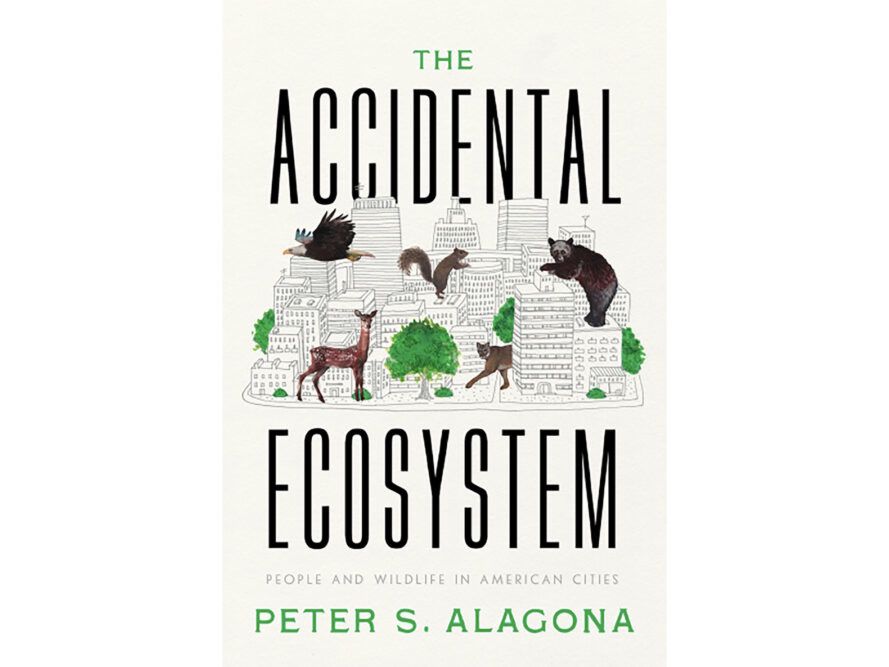
“The Accidental Ecosystem” that’s right outside your door
Raccoons raiding your garbage, squirrels on wires, coyotes scouting for pets left out after dark — they’re not the urban riffraff of the animal world. According to author Peter S. Alagona, “The recent explosion of wildlife in American cities is one of the greatest ecological success stories since the dawn of conservation, but it happened largely by accident.”
Continue reading below
Our Featured Videos
In his fascinating book “The Accidental Ecosystem“, Alagona helps readers peer into the secret lives of the wildlife next door and details how certain species came to thrive in urban areas. The book is full of surprising revelations and historical tidbits.
Related: These works of art record and provide shelter to urban wildlife

Urban areas are natural areas
Why would animals want to dwell in big cities? Well, because they already did before humans got there. In fact, some of the same geographical features that attracted humans to set up shop are also attractive to wildlife. For example, places with protected coastlines, potable freshwater, varied habitats and navigable rivers beckon to both man and beast.
“In the U.S., major cities are disproportionately located on sites with high natural levels of biological diversity,” Alagona writes. As of 2020, fourteen of the fifty largest U.S. cities occupied areas of “very high” biological diversity, even though these areas made up less than 2% of the country’s land base. In addition to residents, these areas host travelers. At least 40 of the 50 largest U.S. cities are located within North America’s flyways. For example, more than 260 species of birds migrate through Manhattan. This pattern also holds true in Europe.
However, urban wildlife hasn’t always been a big area of study. People drawn to wildlife usually want to get out of the city, not hang out in sordid alleyways observing rats and raccoons. But Alagona, a professor of environmental studies at the University of California, warmed to the topic.
“For decades, most scientists and conservationists shunned urban areas and the creatures that inhabited them, focusing instead on rarer species in more remote areas,” he writes. “People who cared about wildlife considered cities artificial, destructive, and boring. There was little to be learned from such places, and even less to be salvaged or nurtured within them. Only recently had wildlife advocates become interested in urban areas. It took them, like me, a long time to start looking. But when they finally did, also like me, they were amazed at what they found.”

History of urban wildlife
Alagona takes readers on a journey back in time. First, the U.S. was sparsely inhabited by Native Americans and the land was largely undeveloped. Then came Euro settlers, who started building up cities and displacing wildlife with a staggering number of domesticated animals. By 1820, New York City’s human population of 122,000 was dwarfed by 130,000 horses, 20,000 pigs and who knows how many cats, dogs, goats, geese, chickens and turkeys. Domesticated animals ruled the streets, displacing wildlife. They ate an enormous amount and expelled almost as much. The stink was insufferable. People lived in fear of rabies.
It’s hard to believe nowadays when city squirrels are constantly darting in front of cars and making homes in people’s attics, but the first squirrel in New York caused a sensation. On July 4, 1856, an eastern gray squirrel escaped from a cage and dashed for freedom. New Yorkers craned their necks to get a glimpse of the creature when it took to the trees.
Over the years, as horses gave way to cars and goats became uncommon sights in cities, the balance shifted. Alagona describes the changing role of dogs as they turned from workers to pets. “From rootless tramps, symbols of moral decay and social disorder, dogs were turning into icons of the nuclear family.” Nowadays, many dogs sleep in bed with their humans. Outside, the trees are full of squirrels.

Living with the animals
Wild animals love to live amongst us because of our lavish lifestyles. And urban animals have street smarts. Raccoons can open latches, locks and zippers, and have even been known to survive after losing limbs or going blind. They thrive in cities. Alagona points out that urban raccoons are fatter, have more offspring and longer lives than their rural cousins.
But living beside wild animals can mean worse problems than ransacked garbage pails. According to Alagona, about two-thirds of the 868 known zoonotic diseases can pass indirectly from animals to humans. And while bats aren’t spreading the biggest killers like heart disease or cancer, everybody who’s survived Covid might feel a bit queasy about the murky unknown of emerging zoonotic diseases.
A thought-provoking read
Animal lovers and anyone interested in the urban ecosystem will likely enjoy this book. Alagona looks at our nonhuman neighbors from so many different perspectives. The book’s illustrations are also fun, depicting scenes like a bull running loose in Brooklyn after busting out of a slaughterhouse, and a whale breaching in front of the Statue of Liberty.
Alagona reminds readers that we are part of the ecosystem, too. “Most of us now live not only among groups of people, but also within diverse multispecies communities,” he said in an interview. “It is our duty to do what we can to foster health, wellbeing, and even joy in the ecosystems we inhabit, because doing so increases the happiness of individuals and because communities are more than just the sum of their parts. We’re all interconnected.”
